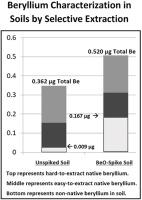Talanta ( IF 5.6 ) Pub Date : 2020-10-16 , DOI: 10.1016/j.talanta.2020.121742 Robert W. Smithwick , Derek H. Bowman , Thomas J. Oatts

|
In the present work, an analytical method has been developed for the determination of the amount of man-made beryllium metal and/or beryllium compounds in soil in addition to the amount of native beryllium that is present. The method is based on the premise that if high-fired beryllium oxide can be extracted efficiently, then beryllium metal and acid-soluble beryllium salts would also be extracted efficiently.
The proposed method involves the addition of 9 mL of an aqueous solution of 5% (wt/vol) ammonium bifluoride (ABF) to a 10-mL tube with 250 mg of dried, sieved soil. The tube is placed in a convection oven at 70 ᵒC and is mechanically rocked for 60 minutes to mix the sample while it is being heated. Beryllium oxide, beryllium metal and beryllium salts would include virtually all of the anthropogenic (man-made) beryllium compounds that might contaminate soil. Compounds that may be naturally present in soil, such as beryllium silicates and beryllium aluminosilicates, are not extracted efficiently by ABF solution under these conditions. As a second step after the initial extraction of the sample of soil with ABF solution, the soil is completely dissolved in a mixture of strong acids and that acid solution is then analyzed to determine the residual beryllium.
The ratio of the extractable to residual beryllium in the same aliquot of native soil can be measured for a soil type in a local region and then used to calculate the amount of anthropogenic beryllium in soil. Therefore, the method may have application in the measurement of beryllium-contaminated soil at sites where beryllium oxide, beryllium metal and/or beryllium salts may have been used.
中文翻译:

通过选择性萃取表征土壤中的铍
在目前的工作中,已经开发了一种分析方法,用于确定土壤中人造铍金属和/或铍化合物的含量以及所存在的天然铍的含量。该方法基于这样的前提,即如果可以有效地提取高烧氧化铍,那么也可以有效地提取铍金属和酸溶性铍盐。
拟议的方法包括将9 mL 5%(wt / vol)的氟化氢铵(ABF)水溶液添加到装有250 mg干燥筛分土壤的10 mL管中。将试管放置在70°C的对流烤箱中,并在加热的同时进行机械摇动60分钟以混合样品。氧化铍,铍金属和铍盐实际上将包括所有可能污染土壤的人为(人造)铍化合物。在这些条件下,ABF溶液无法有效地萃取土壤中天然存在的化合物(例如硅酸铍和铝硅酸铍)。在使用ABF溶液初步提取土壤样品之后的第二步,
可以测量本地土壤相同等分试样中可萃取铍与残留铍的比例,以用于当地区域的土壤类型,然后将其用于计算土壤中人为铍的含量。因此,该方法可能适用于在可能已使用氧化铍,铍金属和/或铍盐的地点测量被铍污染的土壤。











































 京公网安备 11010802027423号
京公网安备 11010802027423号